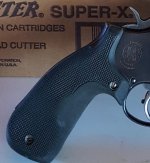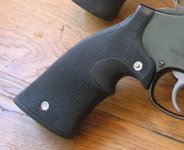Make sure that the grips fit your hand.
This is a profound statement that is worth some old old school information tacked onto it.
Very few people really consider what "fit" means. For so many we have had to work around the magazine inside the grip that the thought that stocks could actually fit your hand doesn't even really register.
If you go back a bit and pick up Walter F. Ropers books you will find that what is most important to your grip on the gun is that your grip is consistent on the gun each time you grasp it, and it doesn't shift due to recoil (causing you to have to re-adjust your grip). Except that you should be able to do this without having a death grip on the gun.
How a gun feels in your hand when you just pick it up, and how that same set of grips performs under recoil are two radically different things in many cases.
Few people really understand just how incredibly technical the old Roper grips actually are. They are usually very attractive, but that is really hiding the treasure they are for shooting.
If they fit you. The problem with old Ropers is that they were mostly custom made... to the specific dimension of the shooter's hand (As traced on paper, or in some cases fit in person). That sort of service is really not realistically available today. But, we can still learn some excellent lessons not just from his books, but observing the grips he had Gagne make for him. I've owned near 20 pair now and only two fit me exactly, which is actually quite lucky.
Based on my experience getting to enjoy the fine old custom grips I usually tell people that its important to get a broad range of custom grips, and shoot with each of them. Which set actually works for you is heavily dependent on your hands. No one can say XYZ grip is the best, because while it may be for them, it might not be for you.
Personally, I am a huge fan of Hogues. He was the clear winner of the LA Shooting team's grip race. But, I should note. If a set of grips fit your hand right then you will probably prefer them in wood, not rubber. It seems like rubber would be superior, but with good fit wood (or old Hogues made of nylon) may work better for you as they do for me. Never be afraid to swap grips willy nilly until you hit on the right pair.


